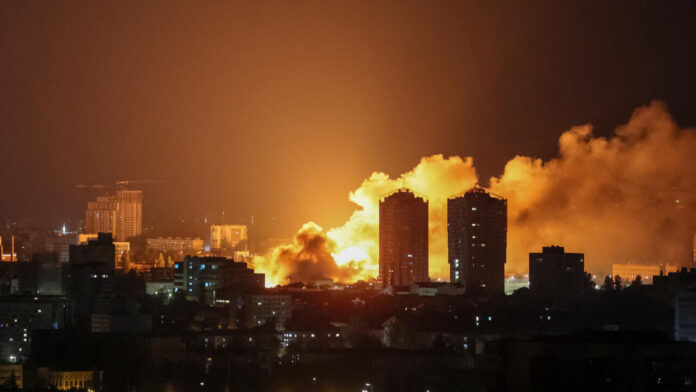In the freezing hours before dawn, Russia launched a massive attack on Kyiv using swarms of drones and cruise missiles. The Ukrainian capital, already worn down by exhaustion and attrition, trembles again, yet this latest assault may speak less to military necessity than to cold strategic messaging.
Kyiv Hit Deep in Its Urban Heart, as the Frontline Stretches Thin
The early hours of Friday were shattered by explosions echoing across multiple residential districts in Kyiv, the result of a deliberate and wide-scale Russian offensive. Officially, at least one person was killed and over a dozen injured, though the true toll may rise.
“The Russians are striking residential buildings. High-rises across nearly every district have been damaged,” declared Timour Tkachenko, head of Kyiv’s military administration. Meanwhile, Mayor Vitali Klitschko urged civilians into shelters, describing an ongoing, large-scale enemy strike on the capital. Fires broke out across several neighborhoods. Heating lines were destroyed—leaving buildings in the Desnianskyi district without heat, a grim omen as winter closes in.
This Russian attack on Kyiv comes as a calculated escalation, not merely retaliation, but part of a broader operational rhythm that blends battlefield gains with civilian destabilization. It’s not new, but it is intensifying.
Precision and Purpose: Russia’s Shift to Long War Doctrine
Unlike the chaotic artillery barrages of early 2022, this strike appears methodical, almost surgical, targeting not just morale but logistics: energy grids, railway hubs, heating infrastructure. This mirrors Moscow’s growing reliance on the “Aleppo model” — destroy resistance by rendering civilian life unbearable.
At the same time, Russian ground forces—larger, better equipped, and now seasoned—continue to push through the Donetsk region, while Western support for Ukraine grows uncertain. Arms shipments from Europe lag. Washington, bogged down in election-year paralysis, offers rhetorical support but little else. By contrast, Moscow has accelerated, clearly embracing a long-war strategy that trades shock for attrition.
The Other Front: Ukrainian Strikes on Novorossiysk
Moscow, for its part, reported intercepting over 200 Ukrainian drones overnight, including 66 over Krasnodar and 59 above the Black Sea. The port city of Novorossiysk, once considered beyond the war’s reach, was hit directly. A local oil refinery was damaged, and a civilian building lost its windows. One man was injured. A civilian ship in the port was also hit—three crew members hospitalized, marking a rare but telling maritime incident.
The strategic implications are not minor. Novorossiysk hosts one of Russia’s key naval and export hubs. Ukrainian capabilities to strike so deep likely involve foreign assistance, though NATO sources continue to issue carefully worded denials.
The Unspoken Message: Western Fatigue and the Frozen Front
What’s striking is not just the violence of the Russian attack on Kyiv, but the silence it has met in Western capitals. NATO convenes, but strategizes little. The U.S. Congress delays aid, and Europe debates energy bills. There is no urgency—only vague declarations of “continued support.”
All the while, Russia presses forward. Kyiv is not merely a target of missiles; it is a test of thresholds: How far can Moscow go without provoking real consequences from the West? So far, the answer appears disturbingly clear: much further.
Fire, Silence, and the Creep of Strategic Paralysis
This latest Russian attack on Kyiv is not just a show of strength—it is a probe, a message sent through fire and silence. Kyiv burns, not only from explosives, but from the slow-burning disengagement of its Western sponsors. The headlines grow fewer. The winter grows colder. The narrative of “defending freedom” sounds ever more hollow against the grind of attrition and diplomacy’s empty chairs.



